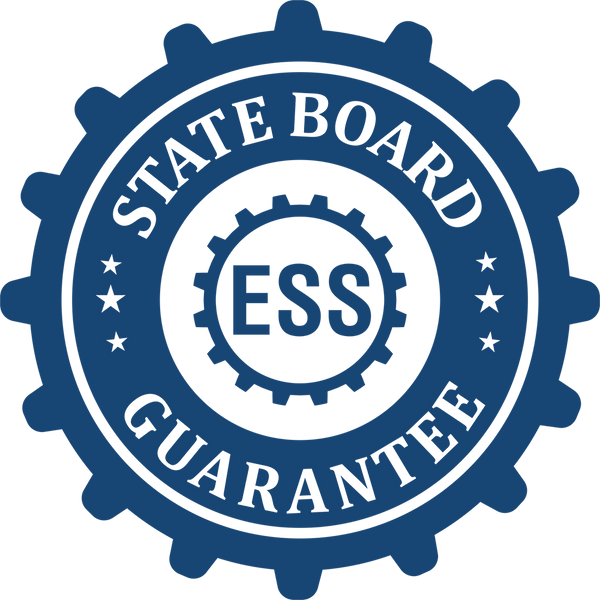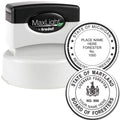If you’re in the market for an inspection stamp for small parts, you’ve come to the right spot. Maybe you’ve struggled with blurred imprints on tiny components or wasted too much time trying to get your company’s mark to fit snugly on small surfaces. In this post, we’ll walk through the ins and outs of choosing a stamp that meets your needs, from ink types to stamp materials. By the end, you’ll know exactly how to find the perfect fit for your inspection process.
ESS has you covered on all fronts. As a family-owned business since 1964, their team has perfected the art of delivering high-quality custom inspection stamps, QA stamps, and QC stamps in a flash. They understand how vital it is for you to make a clear impression on fragile or oddly shaped surfaces. Let’s dive in and explore how you can select a stamp that consistently yields crisp, legible marks.
Understand The Role Of Inspection Stamps
Inspection stamps are designed to confirm that items have passed certain quality-control checks, met specific guidelines, or received safety approval. This might be crucial for industries like electronics, medical devices, automotive supply, or any field where smaller parts play a big role in a product’s overall function.
Why Small Parts Demand Precision
Tiny components often require a high level of precision. Even the tiniest smudge can obscure vital markings that indicate approval status. For instance, if you manufacture circuit boards, each board might contain multiple spots that need an inspection mark. When the available space is minimal, you’ll need a stamp crafted to make a clean impression in that limited area. By choosing the right shape and size, you minimize ink bleeding and deliver a crisp design that’s easy to read.
A practical approach is to think about the final look of your stamped area. Is it going on a curved surface, such as the side of a pipe fitting or medical vial? Or is it a flat surface, like a small plastic connector? Deciding on these details early will help you narrow your stamp shape and size.
Overcoming Common Frustrations
When stamping on petite parts, a few headaches can crop up:
- Ink smearing from too much pressure
- Fading marks that don’t stand out
- Difficulty in positioning the stamp on a curved edge
- Constant re-inking because the stamp’s surface is too large
Addressing these challenges starts with picking a properly sized stamp and pairing it with ink designed for your specific material. Pinpointing what you need up front saves a lot of trial and error later.
Choose The Right Stamp Options
Ready to pinpoint the best stamp for your tasks? You’ll want to consider a few key factors, including ink types, stamp materials, and the environment where you’ll use it.
Types Of Inks And Surfaces
Not all inks are created equal. The surface you plan to imprint (metal, plastic, or rubber) will partially determine which ink type is appropriate. Below is a quick reference:
| Surface | Recommended Ink Type | Key Benefit |
|---|---|---|
| Metal (steel, aluminum) | Fast-drying, oil-based inks | Resists smudges even on slippery finishes |
| Plastic (PVC, ABS) | Quick-drying solvent inks | Reduces the risk of smears |
| Rubber or silicone | Specialty ink with high adhesion | Helps the mark hold up after bending or flexing |
| Painted or coated surfaces | Permanent ink, often solvent-based | Maintains clarity on top of coatings |
Selecting the correct ink for your particular surface ensures you’ll get a durable impression. If you’re dealing with multiple materials, you may need different ink pads or even multiple stamps to handle each type effectively.
Materials And Durability
When it comes to the actual stamp body, materials vary. You’ll often see rubber stamps, polymer stamps, or self-inking options. Rubber and polymer can both handle intricate designs, but:
- Rubber stamps last a long time with proper care and usually work well with many ink types.
- Polymer stamps capture fine detail beautifully, often producing very crisp impressions on small areas.
- Self-inking stamps streamline the process by housing ink inside the device, though you’ll want to confirm they align with your specific application (they may not be ideal for specialized surfaces or extreme environments).
Another point to consider is the handle or mount. If you stamp frequently, a comfortable grip is worth it. The best solution is the setup that keeps your hand from cramping after frequent use, because consistent pressure ensures consistent marks.
Discover ESS’s Custom Approach
When your business—electronics, mechanical assembly, medical, or something else—depends on sharp markings, you want a stamp that’s tailor-made for your workflow. That’s precisely where ESS stands out. They’re not just an off-the-shelf supplier but a top-notch source for custom inspection stamps, QA stamps, and QC stamps.
Personalizing Your Stamp With Logos
Do you need your company’s branding on each part for traceability? Consider working with ESS to create a custom logo stamp. It can include the complete design of your brand or a simple icon. If you’ve ever wanted to display your corporate identity on your parts, a company logo inspection stamp could be the perfect solution. Using a well-crafted logo stamp reassures your customers that you’ve thoroughly tested each piece before sending it out.
Crisp and professional marking sends a strong message about your brand’s commitment to quality. Plus, it makes it easier to track counterfeit products or confirm in-house inspections. With a comfortable grip, durable materials, and perfect sizing, you can count on each impression to look just as you envisioned.
Family Owned, Fast Turnaround Service
Since 1964, ESS has taken pride in offering personalized service that keeps customers coming back. Nothing beats talking to a real person who actually cares about your unique challenges. If you’re in a rush or need a fast pivot, ESS’s team excels at quick turnarounds. They know you don’t have time to chase down a supplier who takes forever.
In addition to speedy service, you get:
- Excellent customer care: ESS is known for walking you through questions about ink types, materials, and maintenance.
- Expert recommendations: If you’re unsure which stamp size or ink formula will hold up best, the ESS team can provide tailored suggestions.
- Flexible designs: Custom shapes, text, or brand logos? No problem. You won’t have to settle for generic solutions that don’t fully fit your product demands.
All these advantages mean you’ll spend less time worrying about your QC process. You can shift that focus to more pressing tasks—like growing your business or perfecting product features.
Consider Proper Stamp Care
Once you’ve picked your ideal inspection stamp for small parts, you’ll want it to stay in top condition for years. Maintenance is pretty straightforward, and a little effort up front can extend your stamp’s lifespan significantly.
Storage Tips
You’ve probably encountered dried-up ink pads or a sticky stamp surface at some point. Luckily, a few simple habits go a long way:
- Keep your stamp covered : If it’s not a self-inking stamp, store it in a protective case or box. This reduces dust buildup and preserves the stamp’s delicate features.
- Avoid direct sunlight: UV rays can harden the stamp material or dry the ink. A dark drawer or cabinet helps maintain ink consistency.
- Seal tight: Make sure your ink pads also have snug-fitting lids, limiting exposure to air that could speed up evaporation.
Maintaining Ink Quality
Choosing high-quality ink that’s suited for your surface is half the battle. But once you’ve opened that ink pad or bottle, you also need to keep it from drying out or becoming contaminated. Here’s how:
- Replenish ink carefully: Add ink to your pad or self-inking device slowly, giving it time to absorb. Overfilling can result in messy prints.
- Keep pads clean: Dust and debris can build up, causing blotchy marks. A quick wipe with a lint-free cloth keeps the surface debris-free.
- Try test prints: Before each batch of stamping, press your stamp on a scrap piece to confirm you’re getting a clear impression. If things look off, it’s time for a quick maintenance check.
Staying proactive on care means fewer unexpected headaches during production. After all, nothing derails your workflow quite like discovering half your latest batch has blurred, unusable marks.
Perfecting Your Approach With ESS
When it comes to marking small parts, there’s no one-size-fits-all method. Every business has its own constraints and goals. By collaborating with ESS, you’ll receive an in-depth consultation on what works best for your situation. That includes picking the right handle, ink composition, and stamp dimensions for your environment.
Think about each step of your inspection process. Do you have to mark items rapidly on an assembly line? Or do you add the QC stamp after a manual check, where speed isn’t as critical? Discussing these details with ESS’s experts early on ensures an efficient setup that fits your timeline and budget.
Why Customization Matters
Off-the-shelf stamps might sound tempting, but they often don’t fully address the complexities of marking very small parts. The curvature of a device or the presence of certain coatings can stress-test a poorly matched stamp. By investing in a custom solution, you’re guaranteeing consistent, repeatable results.
Moreover, your brand identity stands out. Add your product code, company logo, or a specialized symbol relevant to your industry. Not only do you confirm quality control, but you reinforce brand trust each time someone sees that crisp mark.
Checking The Results
Once your stamp arrives, allocate time for quality testing:
- Stamp a small batch of parts.
- Inspect the marks under the same conditions your parts usually encounter (exposure to oils, chemicals, or packaging friction).
- Evaluate clarity, durability, and color retention.
- Adjust pressure and angle as needed.
This approach helps you make any final tweaks. If you need more robust ink or a slightly revised stamp, ESS’s customer-focused team is there to help. It’s a collaborative process that ends with a stamp you’ll rely on for the long haul.
Troubleshooting Common Issues
Occasionally, you might notice issues like incomplete stamping or faint marks. Here are some quick fixes:
Uneven Impressions
Symptom: One side of the stamp doesn’t print.
Cause: Uneven pressure or a worn-out stamp surface.
Fix: Use even downward pressure. Check for any damage or warping in your stamp and replace if needed.
Ink Smudges
Symptom: Smeared or blurred lines.
Cause: Ink not drying quickly or stamping with too much force.
Fix: Switch to a faster-drying ink and ease up on pressure to keep the imprint sharp.
Excessive Bleeding
Symptom: The mark spreads beyond the intended outline.
Cause: Ink that’s too runny or a pad that’s oversaturated.
Fix: Use ink formulated for smaller areas or dab off excess ink on a scrap piece of material first.
Learning to diagnose these minor issues quickly saves you both time and resources. The more familiar you become with your stamp’s quirks, the easier it is to adapt your technique.
FAQs
Below are a few questions people often ask about selecting and using inspection stamps for small parts.
How do I choose the right size stamp for tiny surfaces?
You’ll want to measure the available space on your component, then opt for a stamp size that leaves a small amount of margin around the edges. ESS can help you refine these measurements so you get a perfect fit.Will a single type of ink work on multiple materials?
It can, if you pick an ink that’s versatile and designed for various surfaces. However, certain inks specialize in adhering to metals or plastics. Test first or get personalized recommendations from ESS if you’re not sure.How often should I clean my stamp?
For best results, do a quick wipe-down after each major stamping session. This prevents dried ink from clogging fine details. If you stamp daily, aim for a weekly deep clean.What if I need my company logo on the stamp?
Custom stamps are ESS’s specialty. They’ll help you incorporate your logo, text, or special symbols so that each impression conveys both approval and brand identity. Check out the company logo inspection stamp option for specifics.How fast can I expect my custom order to ship?
ESS is known for lightning-fast turnaround. Once you finalize the design, you can generally expect shipping within a few days. In urgent cases, they’ll work hard to expedite your order.
Key Takeaways
An inspection stamp for small parts must be precise, durable, and convenient to use. Between ink type, stamp material, and custom design options, there’s a lot to juggle. Fortunately, ESS has guided countless businesses through these decisions. Their friendly, family-run approach makes the process feel less intimidating. Before you finalize any stamp order, keep a few points in mind:
- Match your ink to your surface. Fast-drying, solvent-based, and specialty inks all have their place.
- Size your stamp properly so you get a legible mark that isn’t oversized or prone to smudging.
- Plan for maintenance. Clean the stamp regularly, store it away from sunlight, and keep ink pads sealed.
- Customize when possible. A custom stamp with your brand’s logo not only certifies product quality, it also reinforces your professional image.
By following these guidelines, you’ll find it easier to secure a stamp that keeps your quality assurance process running smoothly. Whether you’re just beginning with small-part inspections or looking to upgrade your existing system, ESS provides the expertise and quick service you’ll appreciate.
Feel free to reach out with questions, or if you’ve got a tip that’s worked wonders for your stamping process. Sometimes the smallest adjustments yield the biggest improvements. Good luck perfecting those tiny but oh-so-crucial marks!


















